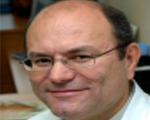Diagnosis
An extensive investigation ruled out various pathologic conditions that could lead to hyperlactatemia. Empirical therapy consisted of discontinuation of the antiretrovirals and administration of L-carnitine and a multivitamin tablet containing thiamine and vitamin B6 (2,3). This was followed by marked clinical improvement and gradual decrease of lactate to 5 mmol/l, 3 weeks later. At this time, and due to a viral load rise, a decision was made to start treatment with nevirapine/saquinavir/ritonavir, (eliminating in this way the NRTIs azidothymidine and lamivudine), and continue the cofactors' supplementation. Six weeks later, symptoms recurred, accompanied by a lactate rise to 12.1 mmol/l. Finally, the antiretroviral regimen was changed to saquinavir/lopinavir-ritonavir and this was followed by normalization of the lactate level (despite discontinuation of the vitamins); this persists up to the last follow-up visit (December 2005). Figure 1 shows the progression of lactate level over time and its association with the therapeutic interventions.
Teaching points
- Hyperlactatemia in HIV-infected patients treated with nucleoside-analogue reverse transcriptase inhibitors (NRTIs) is a well-known adverse reaction (1). However, inconclusive data exist regarding its association with the other two widely used classes of antiretrovirals, non-nucleoside reverse transcriptase inhibitors (NNRTIs) and protease inhibitors (PIs).
- Our report presents a well-documented case of hyperlactatemia associated with the use of the NNRTI nevirapine. In fact, determination of the Naranjo probability scale reveals a score of 9, indicating a "highly probable" adverse event (4).
- Of note, a recently published cohort study (5) revealed an association between the NNRTI efavirenz, but not nevirapine, and hyperlactatemia, while, in the past, a similar association was also shown with the protease inhibitor ritonavir. Even though we did not perform sophisticated biochemical analysis (e.g., determination of the enzymatic activity of the respiratory chain and documentation of mitochondrial DNA depletion), and we cannot exclude the possibility that the first episode of hyperlactatemia was related to the combination of NRTIs and the second episode related to the combination of PIs, we think it is more logical to pinpoint nevirapine as the culprit medication.
- We suggest that clinicians taking care of HIV-infected patients should be vigilant of the development of hyperlactatemia, even in non-NRTI-including regimens.
Acknowledgements
This case was prepared for our website by Drs. George Panos and Petros Kopterides.
References
1. Claessens YE, Chiche JD, Mira JP, Cariou A. Bench-to-bedside review: severe lactic acidosis in HIV patients treated with nucleoside analogue reverse transcriptase inhibitors. Crit Care. 2003;7:226-32.
2. Claessens YE, Cariou A, Monchi M, et al. Detecting life-threatening lactic acidosis related to nucleoside-analog treatment of human immunodeficiency virus-infected patients, and treatment with L-carnitine. Crit Care Med. 2003;31:1042-7.
3. Bowers JM, Bert-Moreno A. Treatment of HAART-induced lactic acidosis with B vitamin supplements. Nutr Clin Pract. 2004;19:375-8.
4. Naranjo CA, Busto U, Sellers EM, et al. A method for estimating the probability of adverse drug reactions. Clin Pharmacol Ther. 1981;30:239-45.
5. Imhof A, Ledergerber B, Gunthard HF, Haupts S, Weber R. Swiss HIV Cohort Study. Risk factors for and outcome of hyperlactatemia in HIV-infected persons: is there a need for routine lactate monitoring? Clin Infect Dis. 2005;41:721-8.



 Ματθαίος Ε. Φαλάγγας, MD, MSc, DSc
Ματθαίος Ε. Φαλάγγας, MD, MSc, DSc Γεώργιος Πέππας
Γεώργιος Πέππας Παναγιώτης Παπαγγελόπουλος
Παναγιώτης Παπαγγελόπουλος Κωνσταντίνος Ρέλλος
Κωνσταντίνος Ρέλλος





